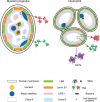In search of the mechanism that shapes the neutrophil's nucleus
- PMID: 28202537
- PMCID: PMC5322735
- DOI: 10.1101/gad.296228.117
In search of the mechanism that shapes the neutrophil's nucleus
Abstract
The organization of the genome within the confines of the nuclear compartment is considered a key contributor to transcription and DNA replication, repair, and recombination. A typical higher eukaryotic cell has a spherical nucleus that is ∼10 µm in diameter. This is not the case for a neutrophil, a short-lived innate immune cell with an unusual multilobular nuclear structure that may serve purposes outside nuclear functions. In this issue of Genes & Development, Zhu and colleagues (pp. 141-153) investigate the neutrophil's genome organization and the mechanisms that contribute to its unique nuclear shape.
Keywords: Lamin B receptor; genome topology; neutrophils; nucleoli; rDNA.
© 2017 Georgopoulos; Published by Cold Spring Harbor Laboratory Press.
Figures

Comment on
-
Comprehensive characterization of neutrophil genome topology.Genes Dev. 2017 Jan 15;31(2):141-153. doi: 10.1101/gad.293910.116. Epub 2017 Feb 6. Genes Dev. 2017. PMID: 28167501 Free PMC article.
References
-
- Kolaczkowska E, Kubes P. 2013. Neutrophil recruitment and function in health and inflammation. Nat Rev Immunol 13: 159–175. - PubMed
Publication types
MeSH terms
Grants and funding
LinkOut - more resources
Full Text Sources
Other Literature Sources
Miscellaneous
